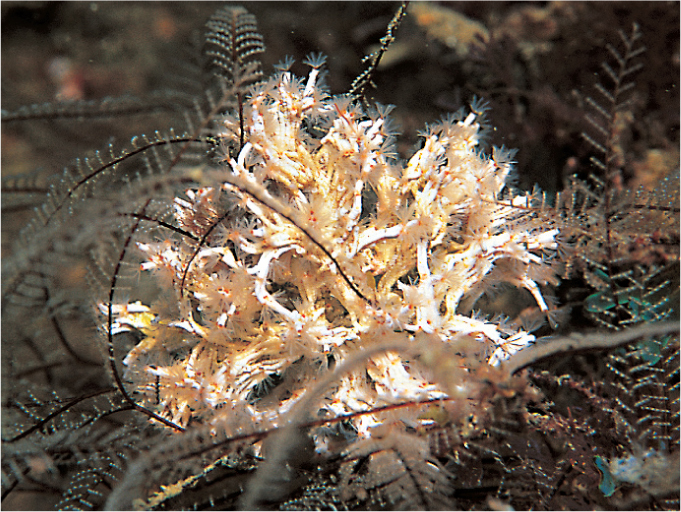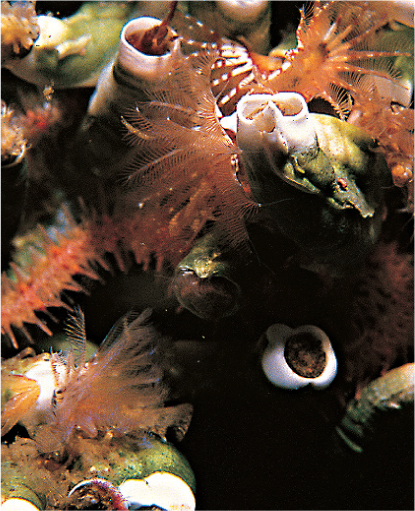
WORMS
There are many different species of worms to be found in the Mediterranean and the group is as diverse as it is interesting. There are the errant flat worms, free spirits to wander at will; there are the nemertid worms, which are unsegmented and have eyes and a mouth and are active hunters on the reef. The polychaete worms generally produce a parchment or calcified tube, which they can hide inside when not feeding. The bristle worms look like centipedes and are active predators on the reef; and there are the annelid worms, which burrow in soft sand and mud.
FLATWORMS
Flatworms have a leaf-like, flat body, which is able to undulate over the seabed by the aid of tiny cilia that beat rhythmically on their underside. Carnivorous animals, the mouth and anus are located on the underside and the head has two lobed projections, which form antenna. They are distinguishable from nudibranchs by their lack of gills.
PINK FLATWORM
Prostheceraeus giesbrechtii

This is the most commonly seen flatworm over the entire region, primarily due to its rather garish purple-and-white striped coloration. Growing to around 2cm (¾in) in length, it enjoys many different habitats from cave and cavern situations with little or no light to bright sandy conditions.
BROWN FLATWORM
Yungia aurantiaca

Also growing to around 2cm (¾in) in length, this flatworm has a golden- to light-brown body with a delicate white stripe around the outside of the body mantle or skirt. The body may also show a pattern of white spots over the entire length.
ANNELID WORMS
GREEN TONGUE
Bonellia viridis

This small exclusive species is instantly recognizable by its long, green, tongue-like proboscis, which splits into two at the end. Gently lobed, it is able to extend its proboscis over 80cm (2ft 8in) from its hold fast under stones or from a rocky crevice. All Bonellia are female and are well known for being able to determine the sex of their larvae. If the drifting larvae, which land on the large proboscis, are male, they cling to the body and change into dwarf males, which then enter the intestines and sexual organs of the female. If the larvae are female they do not attach themselves but will settle onto a suitable habitat and develop into females within a year.
POLYCHAETE WORMS
Polychaete worms are segmented worms with eyes and are more commonly recognized as the wreathy tuft of bristles or fans, which protrude from a tube. Split into two families: the errant worms, which wander at will; and the sedentary worms, which are attached.
ERRANT WORMS
SEA MOUSE
Aphrodita aculeata

Around 10cm (4in) long, the sea mouse has an elongated oval body covered in fine, grey hairs. The flanks are the most distinctive, having iridescent green and golden hairs or bristles and lustrous brown spines. An active hunter on soft sand or mud, it is able to burrow into the substrate.
BEARDED FIRE WORM
Hermodice carunculata

This species is found in all of the world’s tropical and subtropical waters, being equally as common in the Caribbean as it is in the Mediterranean. It is able to grow up to 30cm (12in) and is an active predator on the reef. It is characterized by the pale brown to gold or red iridescent, slender, segmented body with a series of tufts of white bristle hairs on its flanks. If accidentally rubbed against the skin, the hairs are needle sharp and easily penetrate the skin, causing severe irritation not unlike a bad burn. It attacks corals and hydroids and is known to kill and eat small sea urchins.
SEDENTARY WORMS
DELICATE CORAL WORM
Filograna implexa

Filograna is one of the most delicate of all the tube worm species. Growing in large interlacing colonies over 15cm (6in) in diameter, its protective tubes are calcareous and only 1–2mm (ca. 1/10in) in diameter. Often growing attached to fan corals, the crown or fan tuft is only 5mm (¼in) across and its base is pale yellow or orange, giving a spotted appearance to the colony. Extremely fragile, the tubes are very vulnerable to damage.
MUD WORM
Myxicola infundibulum

Quite distinctive in appearance, Myxicola enjoys a muddy or soft sand substrate, quite often at the entrance to caverns where there is a continuous collection of detritus. Surprisingly versatile, this species of sedentary worm has been observed by the author around the British Isles, Scandinavia and even off Newfoundland, where it enjoys an interesting habitat on several deep wrecks at temperatures plunging to 0°C. Usually pale purple or greyish-white in colour, the protruding fan is crater-like in appearance and is quickly retracted should danger threaten. Each of the tips of the fan is a dark brown and the fan tentacles are connected by a thin film. The parchment-like tube is rectangular and rarely protrudes above ground level. The worm is 3cm (1¼in) long.
INQUISITIVE TUBE WORM
Polycirrus sp.

Often overlooked by divers, this small worm is easily recognized by its trail of numerous thread-like tentacles, which snake over the rocky surface searching for food particles in the surrounding area. The main body of the worm is always hidden inside a hole or rocky crevice and is quite often additionally protected by sponge growth. The white tentacles can be over 15cm (6in) long.
SMALL TUBE WORM
Pomatocerous triqueter

Often overlooked due to its small size, this tiny tube worm is quite common on the lower shore and can be found on many stones and rocky surfaces. Characterized by having an obvious diamond-shaped tube, often overgrown by algae, the mouth of the tube can be tinged from green to red. The spiral fan tuft is spotted and can be virtually any colour, from white and blue to green and purple. The raised calcareous tubes are usually curled and around 5cm (2in) long.
WHITE TUFTED WORM
Protula tubularia

Often mistaken for Serpula vermicularis, this species is generally larger with the fan tuft being around 3cm (1¼in) in diameter. It is generally white or pale cream in colour and will have regular spots up each of the tentacles. Spirally extended, this animal is also differentiated by not having a protective operculum or trap door for its calcified tube.
PEACOCK WORM
Sabella pavonina

A common species, generally inhabiting soft sand or muddy sea floors in sheltered low-light conditions. The tube is of parchment construction and is quite stiff. The head of the fan is around 7cm (2¾in) in diameter and is coloured in shades of brown or orange in concentric rings, giving a very pleasant effect when viewed. It is more regularly associated with the cliffs and wrecks of the Scottish west coast and the fjords of Scandinavia, where this tube worm can form large colonies in deep colder waters with poor light. Light and pressure sensitive, the fans are quickly retracted inside its tube should danger threaten. It would appear that the Peacock Worm is equally at home in strong current or sheltered deep inside caverns, as it is in the Mediterranean.
VARIABLE TUBE WORM
Serpula vermicularis

This species is very distinctive in colour, ranging from brilliant orange to purple. It is only 2cm (¾in) in diameter and slightly horseshoe-shaped. The protective cap or operculum of its calcified tube home is clearly visible. Enjoying rocky walls and low light in well-aerated water, this tube worm is light- and pressure-sensitive and can quickly retract its feeding fan should danger approach. Often mistaken for Protula tubularia (see here).
SPIRAL TUBE WORM
Spirographis spallanzani

This is the largest of the tube worms and grows out on long thin parchment tubes perhaps 30cm (12in) long. It enjoys a mixed habitat of cave and cavern, rock wall or Posidonia beds. Spirograph shaped, the fan may consist of eight or ten whorls, which are varicoloured. They are light- and pressure-sensitive and often withdraw back into their tubes before you can get near them. The fan may be as much as 15cm (6in) in diameter.